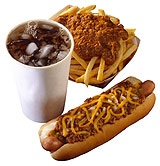
TUESDAY, Aug. 9 (HealthDay News) —
Kids’ meals at fast-food restaurants are high in fat, calories and sodium, a new study shows.
In fact, researchers from the University of California, San Diego, found kids’ fast-food lunches, often offered as rewards, accounted for up to 51 percent of most children’s daily caloric needs and more than 50 percent of their recommended daily sodium intake (100 percent of recommended sodium levels for preschoolers). Moreover, at least 35 percent of those fast food calories came from fat, the study noted.
“We found that families perceived fast-food restaurants as easy and cheap, and many were using fast food as a reward for their children,” Kerri N. Boutelle, behavioral director of the Weight and Wellness Clinic at the University of California, San Diego and Rady Children’s Hospital-San Diego, said in a university news release. “Considering the high prevalence of fast-food consumption by adults as well as kids, it’s important to recognize the impact of fast food and its impact on the current obesity epidemic in the U.S.”
Over the course of six weeks, the researchers surveyed 544 families with children as they entered a fast-food chain restaurant located inside the Rady Children’s Hospital for lunch. Although the families’ receipts were collected to record what they ordered, they were asked to explain what they chose and why. For instance, they had to clarify who ate particular items, if food was shared and if their sodas were diet.
The study found the foods most often bought for preschoolers were French fries, soda, chicken nuggets, cheeseburgers and hamburgers. Older children ate similar foods along with hot apple pies (ages 6 to 11) and chocolate chip cookies (ages 12 to 18).
Soda was also ordered more often than milk or juice, the researchers added. The families also passed over healthier food options, like fruit parfaits, in favor of more traditional fast foods.
The study authors pointed out the fact that the fast-food restaurant was located inside a children’s hospital may have influenced their results since the families’ options may have been limited. Although they had the families’ receipts, the researchers admitted they had no way of confirming exactly how much each person ate.
The study, published in the journal Childhood Obesity, also revealed that families went to the fast-food restaurant for the following reasons:
- The children (and the adults) liked the food
- Convenience
- The fast food was a reward
- The family was hungry, and had no other food options
The toys included with the children’s meals were not a big factor in the families’ decisions to choose fast food. In fact, the researchers noted 49 percent of the families surveyed said that didn’t enter into their decision at all.
The study’s authors concluded that families should receive more information on proper nutrition, taking into account that people simply like fast food. “Bottom line, we need to educate families on making health decisions when in a fast-food restaurant,” Boutelle said.
More information
The American Academy of Pediatrics provides more on children’s nutrition.

